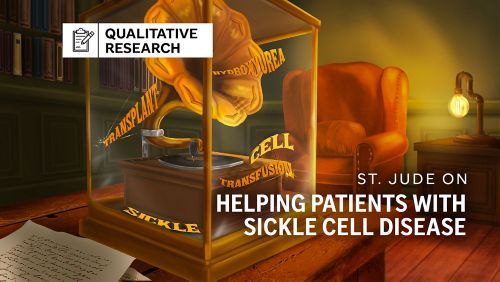St. Jude Family of Websites
Explore our cutting edge research, world-class patient care, career opportunities and more.
St. Jude Children's Research Hospital Home

- Fundraising
St. Jude Family of Websites
Explore our cutting edge research, world-class patient care, career opportunities and more.
St. Jude Children's Research Hospital Home

- Fundraising
Overcoming the medical communication ‘telephone game’ for patients with sickle cell disease

A drawing of a gramophone spouting sickle cell disease medical terms, surrounded by a glass case, representing the disconnect between provided health care information and what patients and families absorb, understand and prioritize, which causes gaps in care. Graphic by Briana Williams.
Imagine a game of “telephone” where one child whispers a word, phrase or sentence into another’s ear. That player then passes the message on in a whisper to the next child in line, a process repeated until everyone except the last player has whispered. The very last in line recites what they heard, which often bears little resemblance to what the first child whispered. When patients with sickle cell disease, the most common inherited blood disorder in the world, receive information about their disorder from clinicians, it can often feel like a high-stakes game of telephone.
Medical language, terms and concepts are often unfamiliar, leaving patients and families to scramble for understanding, like the last child in a game of telephone. This disconnect has real consequences, as it leads to patients and families not prioritizing interventions and actions that could help them in the long term, ultimately resulting in worse health and quality-of-life outcomes.
“I initially started my research looking at cognitive challenges faced by patients with sickle cell disease,” said Andrew Heitzer, PhD, ABPP-CN, St. Jude Department of Psychology & Biobehavioral Sciences. “I looked at different intervention studies to address these needs for people with sickle cell disease, and all the programs had failed in one way or another, but it was unclear why. I realized we needed to understand what the families’ needs were from their perspectives before we developed anything to ensure our interventions would be acceptable to them.”
Qualitative research skills find telephone game-like breakdown in health communications
Heitzer’s earlier work documented cognitive and educational difficulties experienced by young children with sickle cell disease. The human brain uses the most oxygen of any organ; as sickle cell disease primarily decreases red blood cells’ ability to deliver oxygen, children with the disorder often experience more neurocognitive developmental issues than their peers. Research showed educational interventions could limit these issues, but among families with sickle cell disease, attendance was poor.
“That made me want to take a closer look and understand what was going on,” Heitzer said. As his traditional quantitative approach was missing something important, Heitzer applied for and received a grant to develop his qualitative research skills. With this fresh approach, his team asked patients, caregivers and providers about their thoughts, and importantly, what these patients and families need.
Though providers identified many perceived barriers to families attending interventions, patients and families largely did not report encountering significant socioeconomic or practical barriers, surprising Heitzer’s team, who published the findings in Frontiers in Pediatrics. Through more interviews with these families, it became clear that the problem was actually one of education and buy-in, as published in Pediatric Blood & Cancer. Combined with interviews with health care providers published in Frontiers in Pediatrics, it became clear what was causing the telephone-like breakdown in communication between best practices, providers, and patients and families. What was needed was better explanations for why these interventions were essential, which also required community providers to have a better understanding of the disease.
Qualitative feedback from patients with sickle cell disease informs more effective interventions
The qualitative research helped provide context for why information about neurocognitive delays was getting lost in the medical “noise” being thrown at families. Heitzer explained, “During doctor visits, patients and families encounter so much information about acute complications, such as severe pain crises, that such a long-term and often invisible problem involving neurodevelopment, which providers often don’t explain well, never gets prioritized as it gets lost in the other more immediately impactful information.”
Using feedback from the patients and families involved in these studies, Heitzer and his team are now running a clinical trial to improve school readiness for young children with sickle cell disease. The team is composed of providers from the School Program, Department of Psychology & Biobehavioral Sciences and trained caregivers of children with sickle cell disease. First, they provide patient education to caregivers to emphasize the importance of these interventions. Second, they incorporate suggestions about creating a community of families with sickle cell disease that can help support each other through living with the disorder. Already, the intervention is proceeding better than previous approaches as families are actively participating.
“Qualitative research can be helpful to engage with families and understand their needs at a different level than quantitative research,” Heitzer said. “It helps get at ‘why’ families are making certain choices, so we can find better ways to communicate with and support them.”
Tackling tricky sickle cell care transitions requires a qualitative framework
On the other end of the spectrum from children, young adults with sickle cell disease also face many of their own unique challenges. People with sickle cell disease aged 18 to 30 years old experience higher mortality rates compared with others of the same age, as well as a greater incidence of poor health across both physical and psychosocial outcomes, as published in HemaSphere. That increased morbidity and mortality appear to be related, at least in part, to fragmented transitions between pediatric and adult health care, which creates a snowball effect of unaddressed issues that build until catastrophe hits.
“That’s why we are looking for ways to improve the health care transition process for patients living with sickle cell disease,” said corresponding author on the HemaSphere paper, Jerlym Porter, PhD, MPH, St. Jude Department of Psychology & Biobehavioral Sciences. Porter researches the barriers to successful care transitions and develops patient-informed interventions to overcome them. She does so using qualitative methods, such as interviews and focus groups.
Patient feedback from these interviews and focus groups gave new insights into the many challenges that impede successful health care transitions, as well as why patients may avoid certain treatments, as published in Blood Advances. Many reported lacking the skills or knowledge to navigate the basics of adult health care, such as making appointments and reading insurance cards, as well as not understanding the specifics of dealing with sickle cell treatments. Those who did make appointments have reported encountering negative stigma from health care providers, in some instances labeling their pain crises as drug-seeking behavior instead of an actual medical emergency. Not surprisingly, but underappreciated in research, these patients are also experiencing all the normal challenges of moving from adolescence to young adulthood. Patients noted significant changes in academics, jobs and moving from their parents’ home, as circumstances that were made more complex by their chronic condition.
Patient-derived solutions improve the pediatric to adult health care transition process
“We talked to teens and young adults with sickle cell disease, and the teens’ caregivers,” Porter said. “We asked them about their perceptions and feelings regarding the transition and what their thoughts were on how they could be best prepared for that transition to adult care. We translated those ideas into programming for our transition program.”
Informed by those patients, Porter and her colleagues created interventions to improve transitions. For example, they created a Skills Lab to teach and test patients’ ability to make appointments, read their insurance information and get their prescriptions filled, an extension of the Self-Management Skills Checklist published by Porter in the Journal of Pediatric Hematology/Oncology. The Skills Lab requires participants to demonstrate competence at these activities, enabling Porter and her peers to provide further education if needed before any real-world consequences arise from lacking that skill.
Also, based on patient feedback, the St. Jude group created a web-based program: the Sickle Cell Transition E-Learning Program (STEP). STEP is a series of educational modules used by people around the country to learn and teach about sickle cell disease during this critical transition age.
To better understand the unique issues of this transition age, Porter is also leading the LEAPS clinical trial focused on directly observing the challenges encountered by adolescents and young adults transitioning care over the course of multiple years.
Qualitative research tells the story of the patient and family experience
To ensure future research for patients with sickle cell disease is informed by patient, family and caregiver experiences from inception, Porter and other scientists at St. Jude are bringing their research plans to the institution’s Hematology Steering Council arm of the Patient Family Advisory Council. This gives stakeholders the chance to address research plans before they start, engage with ongoing studies, and learn the results afterward.
“We’re working to incorporate qualitative research by including the patient and caregiver perspective early in the process,” Porter explained. “We are partnering with them as we develop our research ideas and methodology, ensuring that our proposals are meaningful and relevant, to empower them to help drive the research that impacts their lives.”
Qualitative research at St. Jude directly impacts the lives of patients with sickle cell disease. Research can be siloed within the scientific and medical communities. However, providers have an obligation to make sure they do not participate in a game of telephone with their patients and their families. Qualitative research can help create a clear and compelling message, both for scientists studying these issues and for the patients their research affects.
“Qualitative research can capture more of the patient’s and family’s real lived experience than quantitative data can,” Heitzer said. “This kind of science can be more approachable, getting away from numbers and instead, just telling the stories of these families, and how we can work together to make their lives better.”






